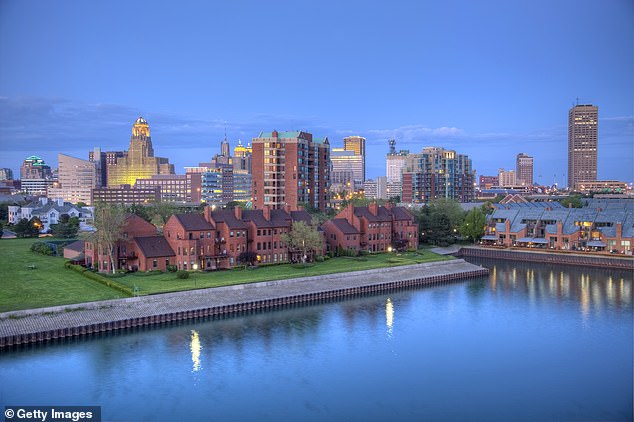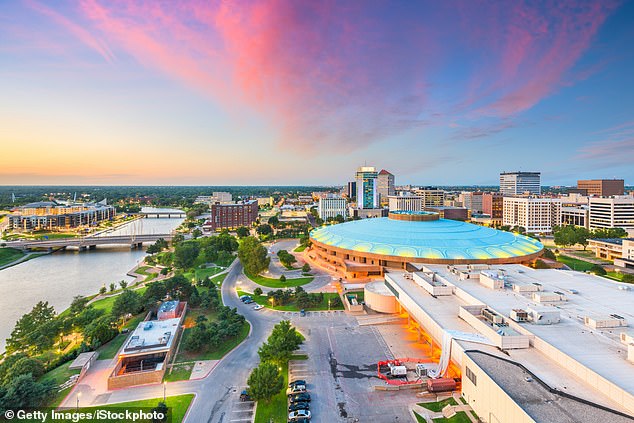Just years ago, $300,000 could snag you a decent home in most areas of the United States.
In fact, before the pandemic hit in 2020, the national median had never hit that level.
But ever since the Covid-19 upended America’s housing market, property prices have soared higher and higher. Today, around $415,000.
With house prices rising — and the cost of everything else going up, too — Americans are looking harder for affordability in every part of life, including where they buy a home.
While many Gen Z and millennial buyers feel shut out of the market, there are still places where $300,000 stretches far.
A new report from Realtor.com has highlighted 10 desirable metros where you can buy a home under $300,000.
‘In these markets, home prices are more closely aligned with local incomes, allowing the typical household to afford the typical for-sale home,’ says Hannah Jones, senior economic research analyst at Realtor.com.
‘The existence of these affordable areas, even if limited, offers encouraging news for buyers committed to purchasing in one of these regions.’

Toledo was named as the top real estate market in spring 2025 by Realtor.com. It’s just 60 miles from Detroit and has a great arts scene

Hannah Jones, senior economic research analyst at Realtor.com
These metros include Muncie, IN, Toledo, OH, and Battle Creek, MI.
Muncie is just an hour way from Indianapolis, and offers 750-acres of reservoir for outdoor enthusiasts to enjoy boating, hiking, and cycling.
Toledo was named as the top real estate market in spring 2025 by Realtor.com. It’s just 60 miles from Detroit and has a great arts scene.
Battle Creek is centrally located between and Chicago, and is known for being a friendly, close-knit city — big enough to offer amenities but small enough that you can easily get to know a lot of people.
Also on the list are Pittsburgh, Cleveland, Scranton-Wilkes-Barre, PA and Buffalo-Cheektowaga, NY.
Pittsburgh is a vibrant, tech-savvy city where historic steel-town grit meets leafy neighborhoods, world-class museums, and a friendly, down-to-earth vibe.
Cleveland is a culture-packed Great Lakes city where world-class arts, hearty food, and lakefront lifestyle blend into a lively urban hub.
Scranton–Wilkes-Barre is a blue-collar pocket of northeastern Pennsylvania where old industrial roots meet small-city charm, leafy mountain backdrops, and a growing sense of revitalization.

Pittsburgh is a vibrant, tech-savvy city where historic steel-town grit meets leafy neighborhoods

Cleveland is a culture-packed Great Lakes city where world-class arts, hearty food, and lakefront lifestyle blend into a lively urban hub
Buffalo–Cheektowaga is a Western New York hub that offers snowy winters, good cuisine, a passionate sports scene, and a rich industrial and cultural history.
Wichita, KS Frankfort, KY, and St. Louis made the rankings as well.
Wichita is a dynamic Midwestern city with aviation heritage, a growing arts scene, and friendly, down-to-earth communities.
Frankfort is a quaint and historic riverfront city where Southern charm, bourbon heritage, and a close-knit community create a quietly vibrant capital town.
St. Louis features iconic architecture, rich musical and cultural history, along with a spirited sports fandom.
Notably, all the areas highlighted are condensed in the Midwestern and Eastern region of the US.
Home prices tend to be more affordable in the Midwest and parts of the East than in the South (in some fast-growing metros) and especially the West Coast for several structural reasons.
In the Midwest and parts of the East, there are large amounts of flat, buildable land, and fewer geographic barriers.

Buffalo–Cheektowaga is a Western New York hub that offers snowy winters, good cuisine, a passionate sports scene, and a rich industrial and cultural history

Frankfort is a quaint and historic riverfront city where Southern charm, bourbon heritage, and a close-knit community create a quietly vibrant capital town

Wichita is a dynamic Midwestern city with aviation heritage, a growing arts scene, and friendly, down-to-earth communities

St. Louis features iconic architecture, rich musical and cultural history, along with a spirited sports fandom
Meanwhile, on the West Coast there are mountains, coastlines, and protected areas restrict where housing can be built.
In the South, there is more land in general, but fast-growing metros like Austin, Nashville, and Atlanta are using up central land quickly.
The Midwest/East is seeing slower population growth, and therefore slower demand for housing.
On the other hand, the South has a very high inbound migration from other states, pushing prices up.
The West Coast has always seen high demand due to climate, economy, and lifestyle.
Separately, home prices in the metros highlighted match the lower wages and lower costs of living that comes with having fewer high-paying jobs in fields such as technology, finance, and entertainment.
Higher wages on the West Coast – home of Silicon Valley, the tech capital of the world, and Hollywood, the entertainment capital of the world — push up home prices.
A similar pattern is seen in the South, as the cost of living rises due to high demand, especially in states such as Florida, Texas, and South Carolina.

